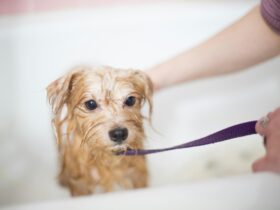Ensuring your dog’s health and well-being is crucial for their happiness and longevity. A well-rounded approach to dog health care involves understanding their nutritional needs, exercise requirements, grooming habits, and preventive care. This comprehensive guide will cover all these aspects in detail to help you provide the best care for your furry friend.
1. Nutrition: The Foundation of Good Health
Proper nutrition is the cornerstone of a healthy dog. A balanced diet supports their growth, energy levels, and overall well-being. Here’s what you need to consider:
A. Choosing the Right Food
- High-Quality Ingredients: Opt for dog foods that list high-quality proteins and whole grains as the primary ingredients. Avoid foods with excessive fillers like corn or soy.
- Age-Appropriate Diet: Puppies, adults, and senior dogs have different nutritional needs. Choose a formula tailored to their life stage.
- Special Dietary Needs: Some dogs may require special diets due to allergies, sensitivities, or health conditions. Consult your vet for recommendations.
B. Feeding Guidelines
- Portion Control: Follow feeding guidelines on the food packaging, but adjust based on your dog’s activity level and weight. Overfeeding can lead to obesity.
- Hydration: Always provide fresh water alongside their meals. Proper hydration is vital for digestion and overall health.
C. Treats and Supplements
- Healthy Treats: Use treats in moderation and choose healthy options like vegetables or specially formulated dog treats.
- Supplements: Consult your vet before introducing any supplements, such as omega-3 fatty acids or glucosamine, to support joint health or coat condition.
2. Exercise: Keeping Your Dog Active and Engaged
Regular exercise is essential for maintaining a dog’s physical and mental health. It helps manage weight, reduces behavioral problems, and keeps their muscles and joints healthy.
A. Daily Exercise Routine
- Walks: Aim for at least 30 minutes of walking each day, but adjust based on your dog’s breed, age, and energy level.
- Playtime: Incorporate play sessions with toys or engage in activities like fetch to stimulate your dog mentally and physically.
B. Tailoring Exercise to Your Dog’s Needs
- Breed-Specific Requirements: High-energy breeds like Border Collies or Huskies require more vigorous exercise compared to lower-energy breeds.
- Age and Health Considerations: Puppies and young dogs have boundless energy, while senior dogs may need gentler activities. Always adjust exercise routines based on their health status.
C. Mental Stimulation
- Interactive Toys: Provide toys that challenge your dog’s problem-solving skills, such as puzzle toys or treat-dispensing devices.
- Training Sessions: Regular training not only reinforces good behavior but also keeps their mind sharp and engaged.
3. Grooming: Maintaining a Clean and Healthy Coat
Regular grooming is vital for your dog’s hygiene and comfort. It helps prevent matting, reduces shedding, and allows you to check for any skin issues.
A. Brushing
- Frequency: Brush your dog’s coat regularly to remove loose hair and prevent tangles. Short-haired breeds may need less frequent brushing compared to long-haired breeds.
- Tools: Use appropriate grooming tools based on your dog’s coat type, such as slicker brushes for long-haired breeds and grooming mitts for short-haired ones.
B. Bathing
- Bath Frequency: Most dogs do not need frequent baths. A bath every 4-6 weeks is generally sufficient unless your dog gets particularly dirty.
- Shampoo: Use a dog-specific shampoo to avoid irritating their skin. Avoid human shampoos, which can disrupt the natural oils in their coat.
C. Nail Clipping and Ear Care
- Nail Trimming: Regular nail trims are essential to prevent discomfort and potential health issues. Trim nails every 1-2 weeks or as needed.
- Ear Cleaning: Check your dog’s ears regularly for dirt or infections. Clean them gently with a vet-approved ear cleaner if necessary.
4. Preventive Care: Keeping Health Issues at Bay
Preventive care helps detect and address potential health issues before they become serious. Regular check-ups and vaccinations are key components of preventive health care.
A. Regular Vet Visits
- Annual Check-Ups: Schedule annual veterinary exams to monitor your dog’s health and address any concerns.
- Dental Health: Dental check-ups are crucial to prevent gum disease and tooth decay. Regular brushing and professional cleanings can help maintain oral health.
B. Vaccinations and Parasite Control
- Vaccinations: Ensure your dog receives vaccinations against common diseases such as rabies, distemper, and parvovirus. Follow your vet’s vaccination schedule.
- Parasite Prevention: Use flea and tick preventatives to protect your dog from parasites. Regularly check for signs of fleas or ticks, especially in warmer months.
C. Identifying Signs of Illness
- Behavioral Changes: Be alert to changes in your dog’s behavior, such as lethargy, loss of appetite, or unusual aggression.
- Physical Symptoms: Monitor for signs of illness, including vomiting, diarrhea, or changes in urination habits. Seek veterinary advice if you notice any concerning symptoms.
5. Creating a Safe Environment
A safe and comfortable living environment contributes significantly to your dog’s health and well-being.
A. Safe Space
- Comfortable Sleeping Area: Provide a clean, comfortable bed in a quiet area where your dog can rest undisturbed.
- Safety Measures: Ensure your home is safe by removing hazards such as toxic plants, chemicals, and choking hazards.
B. Socialization and Mental Health
- Socialization: Regularly expose your dog to new experiences, people, and other animals to promote a well-adjusted temperament.
- Attention and Affection: Spend quality time with your dog, offering affection and companionship to support their emotional health.
Conclusion
Effective dog health care encompasses a range of practices from proper nutrition and exercise to grooming and preventive care. By understanding and addressing each of these areas, you can ensure your dog leads a healthy, happy life. Regular vet visits, a balanced diet, and an active lifestyle are foundational elements, while grooming and preventive measures help keep your dog in optimal condition. Remember, every dog is unique, so tailor these guidelines to suit your pet’s specific needs for the best results.











Leave a Reply